Victorian Women Writing: A Work of Proto Feminism
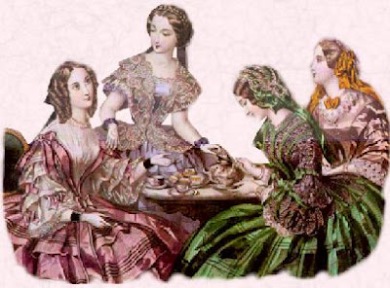 The history of England is the history of the male line, not of the female. We know always some fact, some distinction about fathers. But of mothers, nothing remains but tradition. It is true that we know nothing of them except their names and dates of their marriage and the number of offspring they begot.
The history of England is the history of the male line, not of the female. We know always some fact, some distinction about fathers. But of mothers, nothing remains but tradition. It is true that we know nothing of them except their names and dates of their marriage and the number of offspring they begot.
Strange spaces of silence seem to separate one period of activity from another. There was Sappo and a little group of women all writing poetry in a Greek island six hundred years before the birth of Christ. They fell silent. Then about the year thousand we find a certain court lady, the lady Murasaki, writing a very long and beautiful novel in Japan. But in England in the 16th century, the women were dumb while the dramatists and poets were most active. Later we see Elizabethan literature pretty much masculine. Then at the end of the 18th century and in the beginning of the 19th century we find women again writing- thus time in England- with extraordinary frequency and success.
Law and custom were, certainly, largely responsible for these strange intermissions of silence and speech. When a woman was liable, as she was in the 15th century, to be beaten and finally flung about the room if she did not marry the man of her parent’s choice; the spiritual atmosphere was not favorable to the production of any work of art. Thus it is clear that the extraordinary outburst of fiction and poetry in the beginning of the 19th century in England was heralded innumerable slight changes in law and customs and manners.And as we know, it is probable, however, that both in life and art the values and views of women are not the same that of men. It is obvious that when a woman ventures herself to write a poetry or novel, we will find that she is perpetually wishing to deconstruct the ideals and values constructed by the opposite sex and establish the insignificant serious, important trial- pre-established by male writers.
In the early 19th century women’s writings were more or less autobiographical. One of the motives that led them to write was the desire to establish their self, expose their own sufferings and to plea their own cause. Commenting upon the themes and imagery of the 19th century women writings – Sandra Gilbert and Susan Gubar observe in “Mad Women in the Attic”:
“ The one plot that seems to be concealed in most of the 19th century literature by women… is some sense a story of the woman writer’s quest for her own story, it is the story, in other words- of the woman’s quest for self-definition.”
Aurora Leigh: Victorian concepts of a woman’s vocation
– Elizabeth Barret Browning
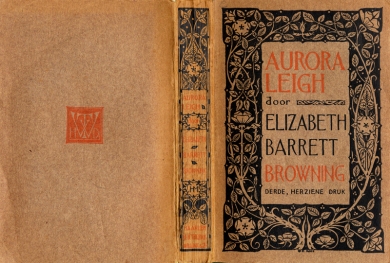 Aurora Leigh expresses Elizabeth Barret Browning’s unconventional views on child labour, prostitution, gender and class conflict. Her heroine’s quench for an independent status as a professional poet, and her questioning of many of society’s established norms and institutions bring forth Elizabeth’s own struggles and intense experiences and we will find it as an “autobiographical discussion” of the feminist issues stated by Elaine Shawalter. The conflict that women in the Victorian age witnessed between their aesthetic vocation and feminine duties are explicitly expressed in Aurora’s struggle to succeed as a poet.
Aurora Leigh expresses Elizabeth Barret Browning’s unconventional views on child labour, prostitution, gender and class conflict. Her heroine’s quench for an independent status as a professional poet, and her questioning of many of society’s established norms and institutions bring forth Elizabeth’s own struggles and intense experiences and we will find it as an “autobiographical discussion” of the feminist issues stated by Elaine Shawalter. The conflict that women in the Victorian age witnessed between their aesthetic vocation and feminine duties are explicitly expressed in Aurora’s struggle to succeed as a poet.Aurora Leigh made a tremendous effect to its age. Elizabeth brings forth the major issues in to the day light- issues of gender roles, women’s struggle for equal and just treatment and class conflict in her poems. She questions the popular Victorian concepts of a woman’s vocation, her status in marriage, family and society and the established notions of virtue and chastity.
She acknowledges the significance of socially constructed norms of sex and genders and address herself through the characters of Aurora Leigh, Marian Erle, and Romney Leigh. Instead of portraying helplessness as the typical feminine behavior she projects strong willed women who pursue their vocation with determination and intelligence. The heroine Aurora wants to become a poet and earn a living through her publication. She wishes to realize fully her intellectual and creative talents. She seeks to acquire a status as an independent and responsible person; she wishes to attain self hood on the basis of her feminine separateness. The poem gradually shows the mutual needs of both men and women.
Aurora’s quest for self hood and freedom to pursue her own plans come in to conflict with her society’s intention to restrict her freedom by binding her into the domestic roles. The open green world of nature where Aurora loves to spend her time offers her a sense of freedom, whiles the life within her home, and reinforces the socially accepted role. Romney’s reaction to Aurora’s plans reflects his disdain towards a woman’s self-awareness and her ambition to become an independent being. And he doubts her creativity and vocation. He is doubtful of her ability to become a good poet. He thinks- as she is a woman and even if she could do so, it would hardly matter. He further states that the world is full of misery and pain that what it wants is not poets, but devoted selfless workers to help humanity. For him, her ambition to become a poet is a selfish, self-centered wish, neglecting the more worthwhile service for humanity.
Aurora’s defense of her choice of career begins by hinting at Romney’s male arrogance towards women. Like other men, he too cannot regard women as independent beings; he thinks them “mere complement of his sex.” She thinks that the image evoked of companionship does not in real life work in that manner, for she finds the man-woman relationship after marriage become an unequal one. In the name of ‘ love’ she finds women cheated in marriage; women become willing slaves and bear the burden of men’s missionary work, without complaining, and without getting any recognition for their contribution. And we see that she is ready to sacrifice her own wishes for a career, where she feels she could also prove to be equally useful to society.
Finally, we see that her reason for not accepting Romney’s proposal of marriage is an emotional one. She feels that Romney’s proposal does not convey sense of love for her. All that he wants is a ‘help mate’, ‘a sister of charity’, not really a wife. We find irony in her words for him that he is already wedded to his social sense:
“Sir, you were married long ago,
You have a wife already, whom you love,
Your social theory.”
She would want a more warm and loving relationship, and a more equal status with in marriage.
Elizabeth expresses powerfully, both, the aspiration and struggle of a young woman and later a subsequent clash between the desire to be an individual being and to be loved. After reading through the poem I feel that it challenges many of the dominant patriarchal notions about women and their duties. It challenges the restrictions placed on women’s self-expression; it “denounces the gospel of self-sacrifice”, and attacks “patriarchal religion”. It is also a search for new heroines, new role-models and new lives which was absolutely a lack of the age.
Goblin market
– Christina Rossetti
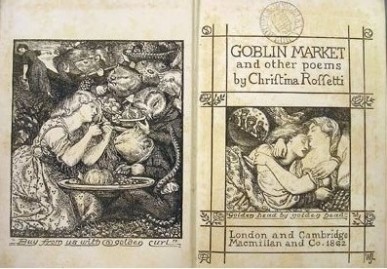 Goblin Market comments on the institutions in Victorian society the Rossetti and her feminist contemporaries wished to see altered, creating modern female heroines to carry out its images. The goblins serve as malicious male figures to attempt the innocent heroines, sisters Laura and Lizzie, to corruption. Rossetti implies that Laura’s demise was caused by in addition to the trickery of the male figures, her own yield to temptation. Fear of desire was a near obsession in Victorian society; yielding was a sign of weakness, and Rossetti’s poem mocks this obsession with its fairytale- like construction. The Victorian people also viewed excessive sexuality in a negative light, associating it with the lower classes and tribal cultures.
Goblin Market comments on the institutions in Victorian society the Rossetti and her feminist contemporaries wished to see altered, creating modern female heroines to carry out its images. The goblins serve as malicious male figures to attempt the innocent heroines, sisters Laura and Lizzie, to corruption. Rossetti implies that Laura’s demise was caused by in addition to the trickery of the male figures, her own yield to temptation. Fear of desire was a near obsession in Victorian society; yielding was a sign of weakness, and Rossetti’s poem mocks this obsession with its fairytale- like construction. The Victorian people also viewed excessive sexuality in a negative light, associating it with the lower classes and tribal cultures.… “Goblin Market” is the epitome of an allegorically feminist work, criticizing Victorian male dominated culture while creating strong feminine heroes that prove the validity of Rossetti’s criticism by embodying the feministic essence she is trying to portray. Throughout the poem, resistance to the male figures is a part of a “painful and strenuous quest that frees the heroine” from dependence on men and liberates her into a world of empowerment in which she can thrive.
George Eliot
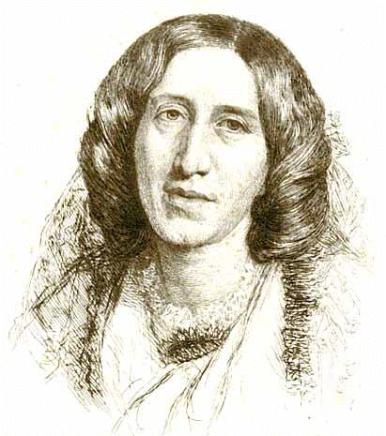 From the perspective of many feminists, Eliot is a disappointment. None of her brilliant, gifted, beautiful, philosophical characters usurp male roles or verbalize the inequality of gender codes. I would like to discuss the common characteristics of her heroines and works.
From the perspective of many feminists, Eliot is a disappointment. None of her brilliant, gifted, beautiful, philosophical characters usurp male roles or verbalize the inequality of gender codes. I would like to discuss the common characteristics of her heroines and works. It would be little hard to find any trace of humor or insight in her works. But we find the vindictiveness of a grudge which we feel to be personal in its origin. She allows her heroines to talk too much. It seems that she has little verbal felicity. But, it is upon the heroines that we would throw a glance. They cannot live without religion and they search for one thing they experienced during the childhood. Each has the deep feminine passion for goodness. In learning they seek their goal both in the wider service of their kind. They do not find what they seek and we cannot wonder because those are kept far from their proximities and they face a number of established norms and institutional correspondences.
For her the burden and the complexity of womanhood were not enough, that she must reach beyond the sanctuary and pluck for herself the strange bright fruits of art and knowledge. It is to be mentioned that Eliot herself explained that she felt that she could serve the cause best as an artist rather than an activist. As a result when we look for feminism in Eliot, we have to look for a much more subtle approach. One way that we can see Eliot acting as an advocate for her gender is in her creation of such believable heroines. Certainly, I think, they are an implicit argument for women’s capacities. After all, her realist approach requires true-to-life endings for her heroines. I think, her heroines, indeed though they leave the readers unsatisfied, they actually have greater consciousness- raising effect than a straighter forwardly “feminist” storyline would do. Finally, on considering Eliot’s feminism or laxity, it is important to keep in mind that many19th century women writers believed that there was an essential feminine nature and it must be followed if civilization required. So thereafter many women writers followed that traditional interpretation of femininity. If we compare the heroines of Eliot with that of others we will find Eliot’s heroines practice the dangerous and damaging habit of self-abnegation. Her characters also express the poignancy and repressed desire.
Jane Eyre and Wuthering Heights
– Charlotte Bronte & Emily Bronte
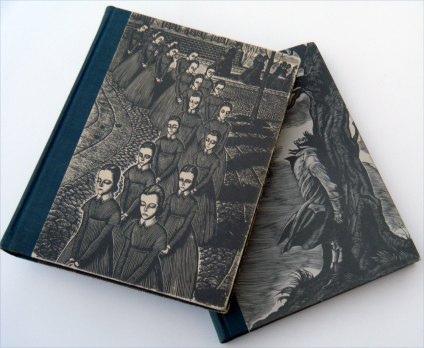 Charlotte Bronte does not attempt to solve the problems of human life; she is even unaware that such problems exist; all her force, and it is the more tremendous for being constricted, goes in to the assertion, ‘I love’, ‘ I hate’, ‘ I suffer’. We read Charlotte not for exquisite observation of character. Her characters are vigorous and elementary; not for comedy- hers is grim and crude; not for philosophic view of life- hers is that of a country parson’s daughter for her poetry.
Charlotte Bronte does not attempt to solve the problems of human life; she is even unaware that such problems exist; all her force, and it is the more tremendous for being constricted, goes in to the assertion, ‘I love’, ‘ I hate’, ‘ I suffer’. We read Charlotte not for exquisite observation of character. Her characters are vigorous and elementary; not for comedy- hers is grim and crude; not for philosophic view of life- hers is that of a country parson’s daughter for her poetry.Wuthering Heights is a more difficult book to understand than Jane Eyre, because Emily was a greater poet than Charlotte. When Charlotte wrote she said with eloquence and splendor and passion ‘I love’, ‘I hate’, ‘I suffer’. Her experience, though more intense, is on a level with our own. But there is no “I” in Wuthering Heights. There are no governesses. There are no employers. There is love, but it is not the love of men and women. Emily was inspired by some more general conception. The impulse which urged her to create was not her own suffering or her own injuries. She looked out upon a world cleft in to gigantic disorder and felt within her the power to unite it in a book. The gigantic ambition is to be felt throughout the novel – a struggle, half thwarted but of superb conviction, to say something through the mouths of her characters which is not merely ‘ I love’ or ‘ I hate’ , but ‘ we , the whole human race’ and ‘ you, the eternal powers…’ the sentence remains unfinished.But it was not enough for Emily to write a few lyrics, to utter a cry, to express a creed. In her poems she did this once and for all, and her poems will perhaps out last her novel. But she was novelist as well as poet.
Conclusion
From the works of 18th and 19th century women writers we get an understanding of the tactics which have been employed by men in order to have the lifelong concept of women to follow the set-code of behavior which fulfills the demands of patriarchy. Many Victorian texts written by male as well as female writers were attempts at defining “womanliness” as also ‘feminine sphere’ of duties. The conflict between the needs of the individual and those of society was heavily turned against women’s self-awareness, by relating her social duty with strong shades of moral duty.
Summing up, we know that the beginning of the feminist movement belongs to the later 19th century. So when we bring forth all the works of female writers of Victorian era, we would know that the female writings of the age paved the passage for the later feminist movement and writings. All works of Elizabeth Barret Browning, Christina Rossetti, Bronte sisters, George Eliot, Gaskel, etc. we’re focusing on the struggles and self-assertion of women of the time. All the Victorian female writings challenge many of the dominant patriarchal notions about women and their duties and also challenge the restrictions placed on women’s self-expression, as vivid in Aurora Leigh. The poem Goblin Market establishes a modern female heroine. Rossetti takes the early manifesto of misogyny, and cleverly twists it around to fit her purpose; a very light, but exceedingly biting mockery of male-dominated culture. Considering the major female writings of Victorian era, it’s worth to note that Victorian female writing as a whole a work of proto-feminism.
